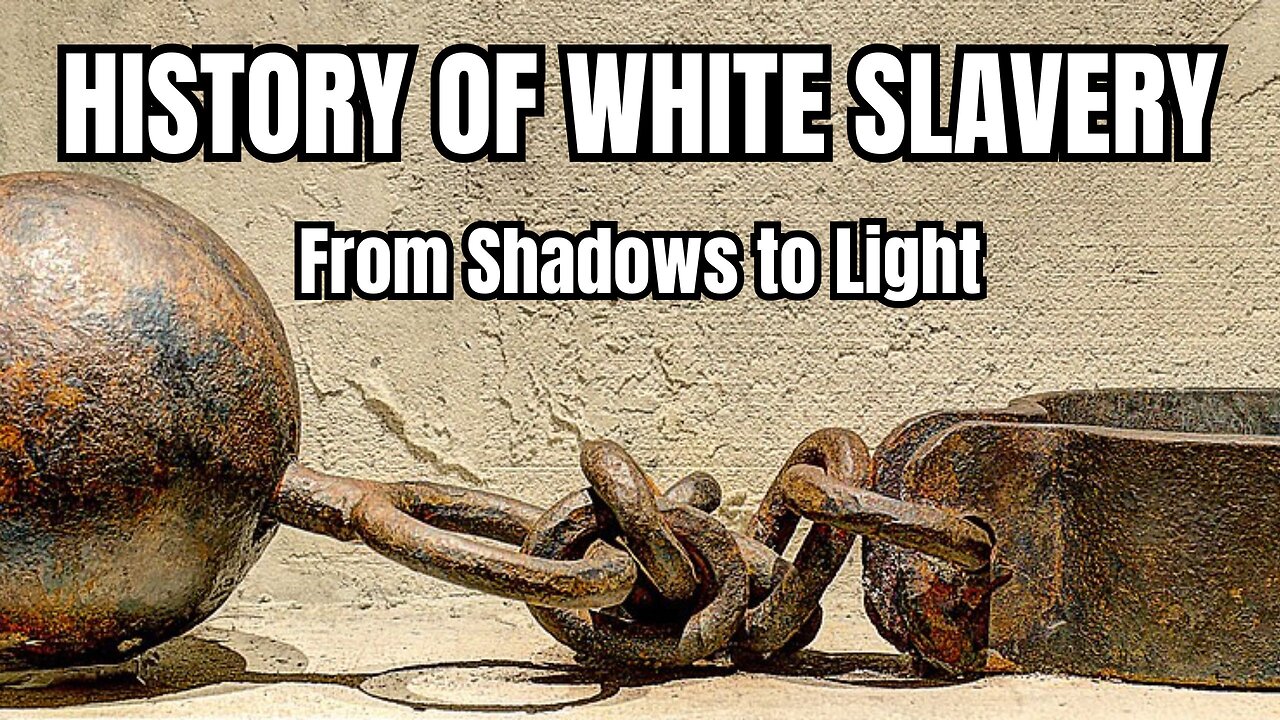Premium Only Content

History of White Slavery: From Shadows to Light CC
White slavery is a crucial part of history that isn’t often discussed. This term refers to the enslavement of Europeans, particularly in the Mediterranean and the Atlantic world from the 16th to the 19th centuries. This dark chapter saw many white Europeans captured and sold into slavery, mirroring the experiences of their African counterparts.
White slavery emerged during a time of piracy and conflict between European powers and the Ottoman Empire. North African pirates, known as Barbary corsairs, frequently raided European coastal towns and ships, capturing men, women, and children. These captives were then sold into slavery in North African and Middle Eastern markets.
Captured individuals faced harsh conditions. Many were forced into hard labor, while others became household servants or were sold into harems. The enslaved endured brutal conditions, long hours of work, and minimal food or rest. They were stripped of their identities, forced to adopt new customs and languages.
Efforts to rescue enslaved individuals were common during this period. Families, churches, and governments sometimes paid ransoms to free their loved ones. Religious orders like the Trinitarians and the Mercedarians were established to negotiate the release of Christian captives. Despite these efforts, many captives spent years, or their entire lives, in slavery.
While the term "white slavery" often conjures images of European captives in the Mediterranean, it also had a presence in America. During the colonial period, many Europeans, including the Irish, Scots, and English, were forcibly brought to America as indentured servants. Although technically different from slavery, the conditions they endured often mirrored those of enslaved people.
Indentured servitude involved individuals signing contracts to work for a certain number of years in exchange for passage to America. However, many were tricked or coerced into these agreements, and their treatment was harsh and exploitative. They faced long hours of labor, inadequate food, and brutal punishments.
In some cases, Europeans were kidnapped and sold into servitude in America. Known as "spiriting," this practice involved abducting individuals, often from ports and streets in Britain, and shipping them across the Atlantic. Upon arrival, they were sold to plantation owners and worked under severe conditions.
While indentured servants had a theoretical path to freedom, many did not survive their term due to the grueling labor and poor living conditions. Those who did often faced continued exploitation and had limited rights compared to free citizens. This system contributed to the socio-economic fabric of early America and laid the groundwork for other forms of forced labor.
The history of white slavery in America is less well-known but remains an important part of the broader narrative of human exploitation and forced labor. Recognizing this history helps us understand the diverse and complex roots of American labor systems and the ongoing struggle for human rights and equality.
Understanding the history of white slavery is crucial. It highlights the widespread nature of human exploitation, showing that people from all backgrounds have been affected by slavery. It also underscores the importance of human rights and the need to combat all forms of slavery that still exist today.
The history of white slavery is a reminder of the brutal past that many endured. Shedding light on this overlooked aspect of history helps us appreciate the progress in human rights and encourages us to fight against modern-day slavery. Remembering these stories ensures that such atrocities are never repeated.
If you found this video informative, please like, subscribe, and hit the bell icon for more historical insights. Share your thoughts in the comments below!
White slavery is a historical fact, but the term has been used in various contexts, often referring to different phenomena. Here are a few contexts in which "white slavery" has been used historically:
Barbary Slave Trade.Christian Slaves, Muslim Masters
Reference: Davis, Robert C. Christian Slaves, Muslim Masters: White Slavery in the Mediterranean, the Barbary Coast, and Italy, 1500–1800. Palgrave Macmillan, 2004.
Indentured Servitude in Colonial America
Reference: Galenson, David W. White Servitude in Colonial America: An Economic Analysis. Cambridge University Press, 1981.
White Slave Trade
This term was also used to describe the forced prostitution of European women, particularly in the late 19th and early 20th centuries.
Reference: Donovan, Brian. White Slave Crusades: Race, Gender, and Anti-vice Activism, 1887-1917. University of Illinois Press, 2006.
These references and excerpts demonstrate the historical contexts in which the term "white slavery" has been used.
-
 7:24:37
7:24:37
Dr Disrespect
10 hours ago🔴LIVE - DR DISRESPECT - WARZONE - NEW SEASON 2 UPDATE
168K28 -
 58:55
58:55
Candace Show Podcast
6 hours agoBACKSTABBED: Justin Baldoni’s Leaked Voicemail, RFK Jr’s Betrayal | Candace Ep 140
132K218 -
 54:34
54:34
LFA TV
10 hours agoThe Deportation Mandate | TRUMPET DAILY 1.28.25 7pm
32.7K3 -
 1:31:36
1:31:36
The Big Mig™
13 hours agoFauci’s Fiction w/ Dr. Michael J Schwartz
45.4K9 -
 1:03:08
1:03:08
Edge of Wonder
5 hours agoChina’s DeepSeek AI Engineered to Censor, Control & Overpower USA
26.8K10 -
 2:16:30
2:16:30
Quite Frankly
7 hours ago"Small Town Charm, ICE ICE Baby, Open Lines" 1/28/25
26.7K14 -
 41:25
41:25
Chrissy Clark
4 hours agoJohn Fetterman TRIGGERS “The View,” Deportations Upset Selena Gomez, & MORE I Underreported Stories
15.1K9 -
 59:42
59:42
PMG
7 hours ago $0.43 earnedManhood in Crisis: What Ancient Rome Can Teach the 21st Century
16.2K2 -
 4:07:35
4:07:35
Akademiks
6 hours agoASAP Rocky Case has Begun . He's facing 24 years for SH**ting his friend!
79K11 -
 1:58:50
1:58:50
Revenge of the Cis
7 hours agoEpisode 1436: Adios Amigo
43.1K6